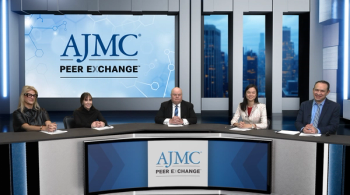
Guideline-Directed HIV Therapies
Key opinion leaders discuss the influence of guideline-directed therapy in the treatment of patients with HIV.
Episodes in this series

Adam C. Welch, PharmD, MBA:Let’s talk about some of the treatment and management of HIV and get into the evidence and guidelines informing our decision-making as we treat patients. Christian, talk to me a little about the guidelines that exist for HIV.
Christian B. Ramers, MD, MPH, FIDSA, AAHIVS: We’re lucky in the field of HIV because we have the DHHS, the Department of Health and Human Services guidelines, which started in the late 1980s as a compilation of all the evidence. CDC [Centers for Disease Control and Prevention], NIH [National Institutes of Health], and HRSA [Health Resources and Services Administration] got together to have 1 place where the best evidence sits. These are continually updated, and we have high-quality, A1-level evidence recommendations for most of the therapies we have. Through the years, it’s been an evolution from targeted therapy for only certain populations of HIV to treating everybody as fast as we can. There’s been an increasing recognition of treatment as an important part of prevention. There’s an acknowledgment that being undetectable means you can’t transmit at all anymore. There have been considerations on the cost that have been introduced recently. Finally, these guidelines have been developed with patients as part of the panel themselves, which is a key innovation. This makes the patient the center of the whole program. These are the central guidelines that everybody adheres to when we’re thinking about how to treat patients with HIV.
Adam C. Welch, PharmD, MBA: Looking at the guidelines, what are some of the goals of therapy for HIV?
Ann Khalsa, MD, MSEd, FAAFP, AAHIVS: These have been mentioned already. If we list them, 1 is durable viral suppression. HIV is a virus that’s constantly reproducing itself with a high error rate. We learned early on in the epidemic that we had to have 3 highly active drugs to fully suppress it. If the virus isn’t completely suppressed, it will still replicate in the presence of drugs, and it will engender and cause resistance to occur. Resistance is the Achilles’ heel of HIV. We heard in the pandemic with COVID-19 that different strains would occur. We had to change off certain monoclonal antibody infusions because they wouldn’t work. That’s an example of resistance. HIV continually does that, more than any other virus, which is why we have no vaccine. We’ll talk about that later.
In terms of treatment, durable viral suppression is usually triplet therapy. But there was a time when 1 of the medications was 6 pills 3 times a day, plus 2 other medications with high rates of diarrhea and adverse effects. These were hard to take. Patients did it because otherwise you died; they saw their friends dying. We’ve come so far from there that we’re down to 1 pill once a day, which encourages and helps reinforce and maintain adherence. Because anytime you skip or miss doses—late pharmacy fills, dropped insurance, maybe you’re high or you’re homeless and you don’t remember, whatever the reason—your drug levels go down, the virus becomes active, and it learns to fight those meds. When you get resistance, those meds will never work again. Resistance is permanent. It’s archived in our immune system, reserve cells, bone marrow, lymph nodes, and that’s forever. [I was giving] 1 pill once a day. You can brush your teeth, take your pill, go to bed, or you can pair it with something to make it easy and doable. Now I’m giving patients regimens. I’ve got someone with resistance that I’m in the process of getting all these meds to. He’s going to get an IV [intravenous] infusion every 2 weeks, he’s going to get 4 different medicines twice daily, and he’s already got full resistance to 3 classes. I’ll be lucky if he’s able to take it. The cost is going to be horrific.
The other thing is tolerability. We gave out meds for diarrhea like candy back in the day. Now I rarely have that issue with patients. If they were having adverse effects, they would say, “I’m going to go work, and I’m going to be on a taping. I don’t want to be running to the bathroom, so I’m not going to take my pills today.” It was common that patients would intentionally miss doses because our meds were too toxic. It was better than dying, but we have meds that are tolerable. Payers want us to go back. After a medicine has been licensed for however many years, it goes off patent. It could go generic, and it’s less expensive. I get that. But the reason we as prescribers were waiting for these newer meds is to avoid kidney toxicity as our patients age, which is a real thing. More than half of my patients in the clinic have advanced cases. More than half of mine are over 50. I’ve got a geriatrics practice. Everyone has high blood pressure, diabetes, high cholesterol, heart disease. I have to use meds that don’t worsen that. Our new drugs don’t worsen that, but our older ones can. Going backward isn’t a matter of money. It’s good medicine for the patient’s health. That’s huge.
Adam C. Welch, PharmD, MBA: We need to think about the big picture. Newer agents are better tolerated and do a better job with viral suppression. That viral suppression helps fight that resistance, which is crucial to all this, and it keeps viral levels low enough so they don’t transmit and continue the epidemic rates.
Ann Khalsa, MD, MSEd, FAAFP, AAHIVS: Exactly.
Adam C. Welch, PharmD, MBA: It sounds as if holistically the data become very important with this. If you’re using old data to make decisions about formularies, it’s not true anymore because of resistance. We need to be current. Science has come a long way, and it’s helped the therapy options in the treatment of HIV. To help prevent that spread, it becomes very important.
Ann Khalsa, MD, MSEd, FAAFP, AAHIVS: For example, you’re talking about data and old regimens. One of our first single-tablet regimens was a drug called Atripla. It was a non-nucleoside with 2 nucleosides—different classes of meds—and we all loved it. It was great. It was the first all-in-1 regimen that we had, but it has a very high risk of resistance. In terms of transmitted resistance, if I’m positive, Christian is negative, and I’m on Atripla noncompliantly and nonadherently, and I have resistance. I now give him resistance. Transmitted drug resistance and the non-nucleosides from that era are the highest group of transmitted resistance, yet I see formularies that want me to go backward and prescribe that medicine. I’m not going to prescribe that medicine. It may not work because there’s still community-wide transmitted resistance. The reason we as prescribers don’t want to use those older medicines is we know there’s resistance in the community. We know about the toxicities. The regimen my multidrug-resistant patient is going on is a lot more expensive than 1 pill once a day of a current good regimen.
Christian B. Ramers, MD, MPH, FIDSA, AAHIVS: Back to the guidelines, these are very well thought out. It’s not just the A1-level evidence in terms of efficacy, but a lot of regimens get demoted through the years and pushed down to other alternatives. There are 4 or 5 recommended regimens for most patients, depending how you count, and we all know what they are. We’re going to talk about them in a second. But we know very well that other regimens are much lower on the recommendation list because of long-term toxicities, and it pains us to think that we might have to go back to those because the toxicities are known.
Transcript edited for clarity.
Newsletter
Stay ahead of policy, cost, and value—subscribe to AJMC for expert insights at the intersection of clinical care and health economics.





























































